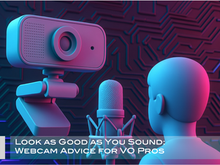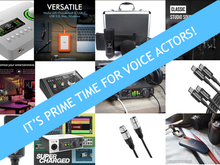"Pop" Culture: The Explosive Truth about your Breath!
- Frank Verderosa
- Apr 17, 2023
- 3 min read
Updated: Sep 11, 2023

I previously posted about booth noise. In this post we’ll look at another consistent issue with voice actors, and some ways to mitigate it. Plosives. P-pops. The big boom-boom. The sub-shaker. The booty-toot. Alright, I made some of those names up- but you get the idea.
Plosives happen when you push a lot of air directly at the diaphragm of your mic. It’s commonly referred to as “P-pops”, because words with P are often problematic. A pop-filter will help a lot with this, but adjusting mic placement and positioning can almost eliminate the need for one. Also, while some large diaphragm condenser mics come with foam covers, those shouldn’t be confused for pop filters or pop shields. While you may have seen those black foam windscreens in use on some more expensive microphones, the kind that come with cheaper mics tend to not work as well.
I’ve written before about the benefits of hanging your mic upside down. This is definitely one of the reasons to do it! Many voice actors show up for consults with their mic right side up, and their script (tablet, computer display, etc) right behind it and slightly below. Unfortunately, this placement puts your diaphragm right in the line of fire of your air! Similarly, shotgun mics, when used in voice over work, don't need you to be right up on them. I've previously written about shotgun mic placement for VO work to avoid plosives.
As with all things audio- while we have tools to fix these issues in post, the should be a last resort. It’s always better to get the best sound going in.
What DOESN’T work
Backing off the mic a little might work at a proper recording studio because you have the room and (presumably) proper acoustic treatments where that shouldn’t negatively impact your sound. But in almost every home booth I’ve heard, whether it's a closet or a Studio Bricks booth, the flaws inherent with squares and rectangles become instantly noticeable the moment you go even slightly off mic. This has to a lot to do with the size of those booths and the nature of comb-filtering: that dreaded "boxy" sound- regardless of how much acoustic material you've surrounded yourself with.
What DOES work
A well placed pop-filter combined with proper mic placement helps a lot. If you're able to get your mic upside down (specifically large diaphragm condensers like the Neumann U87, Rode NT1, etc) align your nose so it's even with the middle or lower section of the mic’s grill. Keep your copy below the mic, as it would be if you were reading a script off a music stand at a studio. This keeps the air away from the diaphragm while still capturing all of the resonance of your voice. If you can’t get you mic upside down for some reason, there are a few tips and tricks to fix plosives while recording.
While backing off can be an issue, sometimes a slight head turn can be a solve. Just don't drift too far off mic. Keep your eyes on it!

Another classic technique, used more for pickups than “in the moment” recording, is placing a pencil, pen, or even a finger vertically in front of your lips when you say the troublesome word. Want to see how well this works? Put your hand about 4 inches from your mouth a make "P" sounds like "puh puh puh". Feel that blast is air against your palm? Now put your pointer finger from your other hand up to your mouth like you're telling someone to be quiet.... maybe an inch from your lips. Make the same sound toward your palm. Feel the difference?
The Bottom Line
If you’re delivering finished audio, and you’re hearing plosives, then you’ll want to learn to use RX DePlosive. As with all of the RX tools, you need to know exactly how much and when to use it. I cover this in my RX class, which you can keep an eye out for under the events page of this website. It does a great job when used properly, but it’s always best to fix it BEFORE it’s recorded.
Years ago, a voice actor entered my booth for an intense, smoldering commercial read. He lifted the pop filter away from the U87, and I politely (foolishly) explained to him why he would want to leave that there. With a voice that implied "Back off, kid, I got this", he explained that he knows exactly where to be on the mic to not pop a P. And he was right, It sounded amazing and there wasn't a single plosive!
With some practice and some vigilance, you may never pop another P! If you're not sure how you're sounding, you might consider booking a 15 minute evaluation where we can check your sound, mic positioning and booth acoustics.





























This is a very helpful and interesting read, Frank ! Thank you for sharing your wisdoms! (puh puh puh test ! wOw)